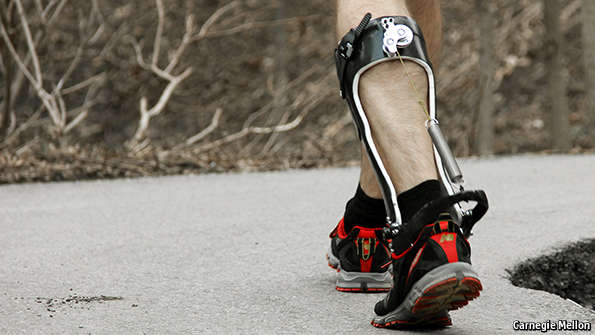
One step ahead
Engineers show off a simple way to make walking more efficient
“THE human body is a machine that winds its own springs,” wrote Julien Offray de La Mettrie, a French physician-philosopher, in 1748. While La Mettrie’s primitive ideas on physiology have long since been supplanted, the idea that the human machinery is particularly finely tuned, particularly when it comes to locomotion, remains. A clever bit of kit described this week, however, suggests that the tuning is not quite perfect.
People have been engaged in a quest to improve upon the bodies nature gave them for about as long as there have been engineers. Nicolas Yagn, a Russian inventor, got a patent in 1890 for his “Apparatus for facilitating walking, running and jumping”, an unwieldy wearable contraption of bendy bow-springs that would in modern parlance be called an exoskeleton.
The idea was to recoup some of the energy of movement, making walking more efficient and thereby less fatiguing. Any gain would be a great help to those who do lots of walking, such as soldiers. But what Yagn and similarly minded inventors have all discovered is that it is difficult to squeeze any more efficiency out of the human machine.
It took until 2013 for the design of a device that worked well enough to offset the effects of its own weight and make a measurable gain in efficiency (as measured by how much oxygen wearers consumed and how much carbon dioxide they produced—a standard proxy for the amount of puff they put into walking).
The device, described in PLOS ONE by researchers from Ghent University in Belgium, was a complex beast of hinges and powered pneumatic pistons that would have made Yagn blush.
Steven Collins, of Carnegie Mellon University, in Pennsylvania, and colleagues went back to basics, and this week report a surprising bit of kit to add to the story. They have developed a simple device of just a few hundred grams’ weight which fits over the lower leg and which can measurably improve the walking efficiency of its wearer. What is surprising is that it does so passively: without any pistons, motors, batteries or anything of the sort.
The device stores energy produced when the wearer lifts a foot off the ground. That movement flexes the ankle, tilts the foot up, and stretches the Achilles’ tendon. That ankle flexure pulls on a cable, which in turn causes the rotation of a clutch that can turn only in one direction. When the foot lands, the clutch is disengaged and the device releases its stored energy, pulling at the back of the ankle in parallel with the recoil of the Achilles’ tendon. That helps with the push-off of the next step.
Dr Collins and company report in the latest issue of Nature that their gizmo improves walking efficiency by about 7%.
Rather than the kind of beefy powered add-on conjured in science-fiction books and films, though, the authors conceive of it as a simple no-extra-energy improvement upon the human machine. That is something that, after more than a century of searching, was thought to be impossible.
The Economist, Ciencia y Tecnología. La Biomecánica: Un paso mas adelante.
